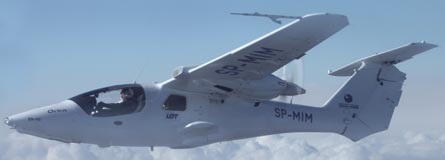All the attention may be on Aviation Valley's efforts to develop an integrated supply chain for the commercial aviation industry, but a group of Polish manufacturers is at ILA in Berlin this week promoting a different and traditional side of the country's aerospace sector: light aircraft.
In communist times, Polish industry - together with neighbouring Czechoslovakia's - built rugged utility and training aircraft that found a market mainly in the developing world as an alternative to North American types.
Now Poland's general aviation sector - like the rest of its industry - is reinventing itself with start-ups looking to establish their own place in the training and recreational arena.
Aero-Kros in Krosno was set up in 2007 as a successor to an organisation that had serviced GA aircraft for 50 years. Its flagship product, the MP-02 Czajka (Lapwing), is a two-seat, T-tail, cantilever-wing composite ultralight, powered by a Rotax 912. Unusually, the aircraft is on display inside the Polish pavilion at the Berlin show.
The Aero Aviation Technologies AT-3 very light trainer and its light sport sibling the AT-3 are also Rotax 912-powered but are by contrast all metal. Set up 16 years ago and based in a new factory, the Mielec company has sold about 100 of its aircraft including 12 in the first two months of this year, and has nine in production, says its chief executive Walter Jankowski. It markets the AT-3 as a "modern alternative to the Cessna 150/152".
 The EM-11 Orka composite, four-seat twin-pusher first flew in 2003. Picture: Marganski & Myslowski |
|---|
WOODEN GLIDERS
In a previous guise, Marganski & Myslowski Zaklady Lotnicze, based in Bielsko-Biala, was one of the first private aviation companies in Poland in 1986. It started by repairing wooden gliders and moved into the design and production of its own glider models, including the MDM-1 Fox, as well as composite structures outside aerospace. Today, after trying in the 1990s to develop a jet trainer, its main aviation activity is the effort to certificate the EM-11 Orka. The composite, four-seat twin-pusher first flew in 2003.
While Poland has a strong GA manufacturing heritage and strong engineering and design skills, it cannot sit on its laurels, believes Jankowski. Although the labour rate is lower than in North America, the US rate can vary regionally and Polish employers have a raft of social costs their American counterparts do not. "There is still a big saving, but it is deteriorating very fast," he says.
The answer, he believes, is for GA manufacturers - like their commercial aviation compatriots - to form manufacturing partnerships with North American companies. "I could offer someone like Cessna a much more economical way of assembling an aircraft," says Jankowski.
Source: Flight International
















